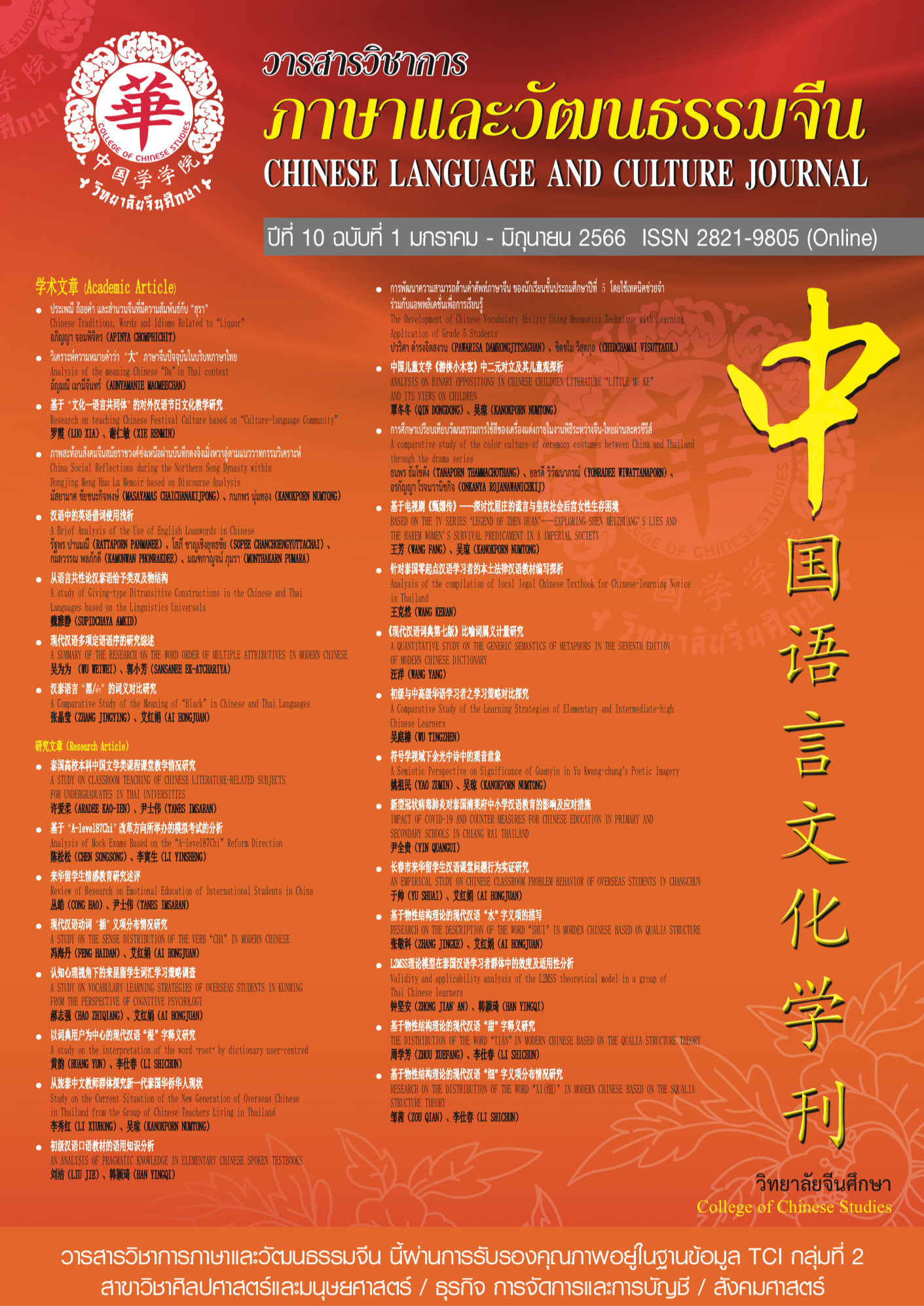A Semiotic Perspective on Significance of Guanyin in Yu Kwang-chung's Poetic Imagery
Keywords:
Yu Kwang-chung, Guanyin, image, poems, SemioticsAbstract
This paper aims to conduct a semiotic analysis of the metaphorical significance of "Guanyin" in Yu Kwang-chung's poems, with the objective of deepening our understanding of the subtle emotional nuances conveyed by this imagery and providing a fresh perspective on the study of his poems. Through meticulous collation and comprehensive analysis, it is found that the image of "Guanyin" assumes the role of a symbol with universal significance, manifested in his 15 poems. Various specific signifiers are employed, including "Guanyin," "Guanyin Shan" (Guanyin Mountain), "Pusa" (Bodhisattva), "Qianshou Guanyin" (Thousand-Hands Guanyin), and "Guanshiyin" (The One Who Perceives the Sounds of the World), each utilized to evoke distinct signified meanings associated with this multifaceted symbol. At different levels of symbolism, the meaning of the "Guanyin" image varies. The metaphorical construction process of the "Guanyin" symbol in Yu's poetry is rooted in the resemblances between its signifiers and signified meanings. These resemblances encompass both the visual representation and attributes of Guanyin, as well as the personal significance of the Guanyin mountain in Yu's life. Yu's unique life experiences and complex emotions imbue the symbol of "Guanyin" with rich meaning, leading to its gradual elevation to higher levels of symbolism. Ultimately, the "Guanyin" symbol evolves into a representation of "hometown," becoming a vehicle for interpreting and expressing Yu 's profound sense of homesickness in his poems.
References
Aristotle. (1954). Rhetoric and Poetics.[M]. New York, NY: The Modern Library.
David Sless. In Search of Semiotics.[M]. Barnes & Noble Books. 1986. 29
Halle M. Fundamentals of language.[M]. Mouton, 1956. 69-96
Peirce C S. Collected papers of charles sanders peirce.[M]. Harvard University Press,1974.
Van Tilburg M A L, Vingerhoets A J J M, Van Heck G L. Homesickness: A review of the literature.[J]. Psychological medicine, 1996, 26(5): 899-912.
白先勇. 蓦然回首.[M]. 尔雅出版社, 1978. 167 - 168
白先勇. 台北人.[M]. 中国友谊出版公司, 1985. 356
陈植锷. 诗歌意象论[M]. 中国社会科学出版社, 1990.
耿占春. 隐喻[M].河南大学出版社. 2007. 152-153
莱考夫, 约翰逊. 我们赖以生存的隐喻.[M]. 浙江大学出版社, 2015. 233
梁小兰.沈从文笔下的观音意象——试论佛教文化对沈从文创作的影响[J].安徽文学(下半月),2009(03):359-360.
刘登翰(2002). 余光中·香港·沙田文学.[C].In: 黄曼君, 黄永林. 火浴的凤凰 恒在的缪斯:余光中暨香港沙田文学国际学术研讨会论文集.[M]. 湖北人民出版社, 2002. 33 - 43
流沙河. 十二象.[M]. 三联出版社, 1987. 183
洛夫.《洛夫诗论选集》自序.[J].中外文学.1977. 5(10).34 - 45.
吕红周. 符号学视角下的隐喻研究:[博士学位论文].[D].哈尔滨:黑龙江大学,2010. 13 - 14
皮尔斯. 李斯卡:皮尔斯符号学导论.(赵星植,译者).[M]. 四川大学出版社, 2014. 32
沈天鸿. 现代诗学:形式与技巧30讲.[M]. 昆仑出版社, 2005.
索绪尔. 普通语言学教程(高名凯,译者).[M]. 商务印书馆, 1980.
台湾交通部观光局北海岸及观音山国家风景区管理处. “观音山”[online]. (https://www.northguan-nsa.gov.tw/user/article.aspx?Lang=1&SNo=04003283), 2022/12/10
余光中. 隔水观音.[M]. 洪范书店, 1983. 176
余光中. 从母亲到外遇. 联合文学.[J], 168期. 46 - 50.
余光中. 余光中集 (第二卷).[M]. 百花文艺出版社, 2003a. 3
余光中. 余光中集 (第四卷).[M]. 百花文艺出版社, 2003b. 350 - 353
余光中. 绣口一开.[M]. 人民日报出版社, 2014.287
余光中. 桥跨黄金城.[M]. 人民日报出版社, 2007. 313 - 316
于君方. 观音.[M]. 商务印书馆, 2012. 413
赵毅衡. 文学符号学.[M]. 北京大学出版社, 2010.
赵志刚,张西艳.华裔作家林宝音小说中的“观音”意象及其叙事功能.[J].华文文学,2020(06): 66-73.
Downloads
Published
How to Cite
Issue
Section
License
Copyright (c) 2023 Chinese Language and Culture Journal

This work is licensed under a Creative Commons Attribution-NonCommercial-NoDerivatives 4.0 International License.
บทความที่ได้รับการตีพิมพ์เป็นลิขสิทธิ์ของวารสารภาษาและวัฒนธรรมจีน มหาวิทยาลัยหัวเฉียวเฉลิมพระเกียรติ
บทความใน “วารสารวิชาการภาษาและวัฒนธรรมจีน” เป็นทรรศนะของผู้เขียนโดยเฉพาะ กองบรรณาธิการไม่มีส่วนในความคิดเห็นในข้อเขียนเหล่านั้น




